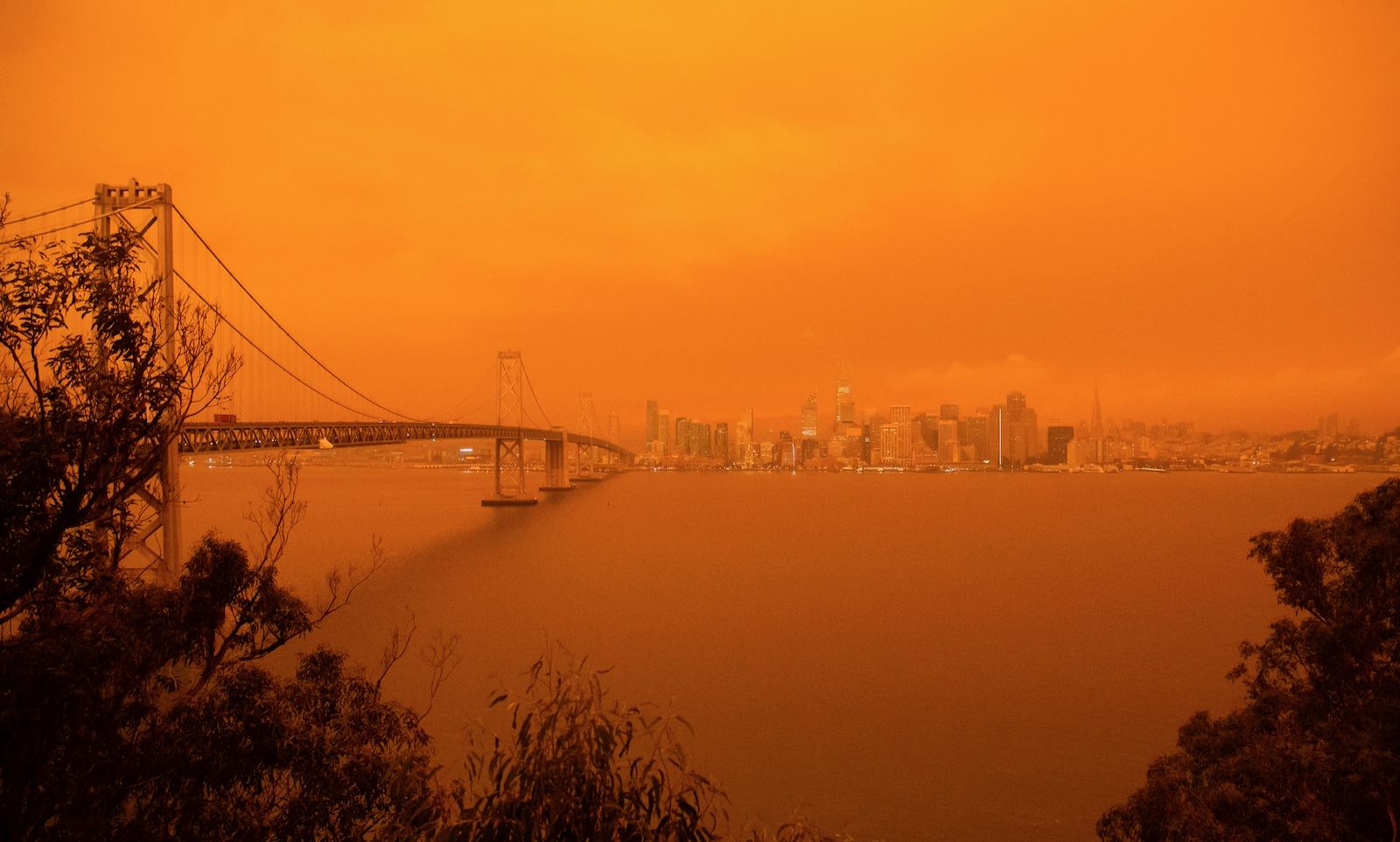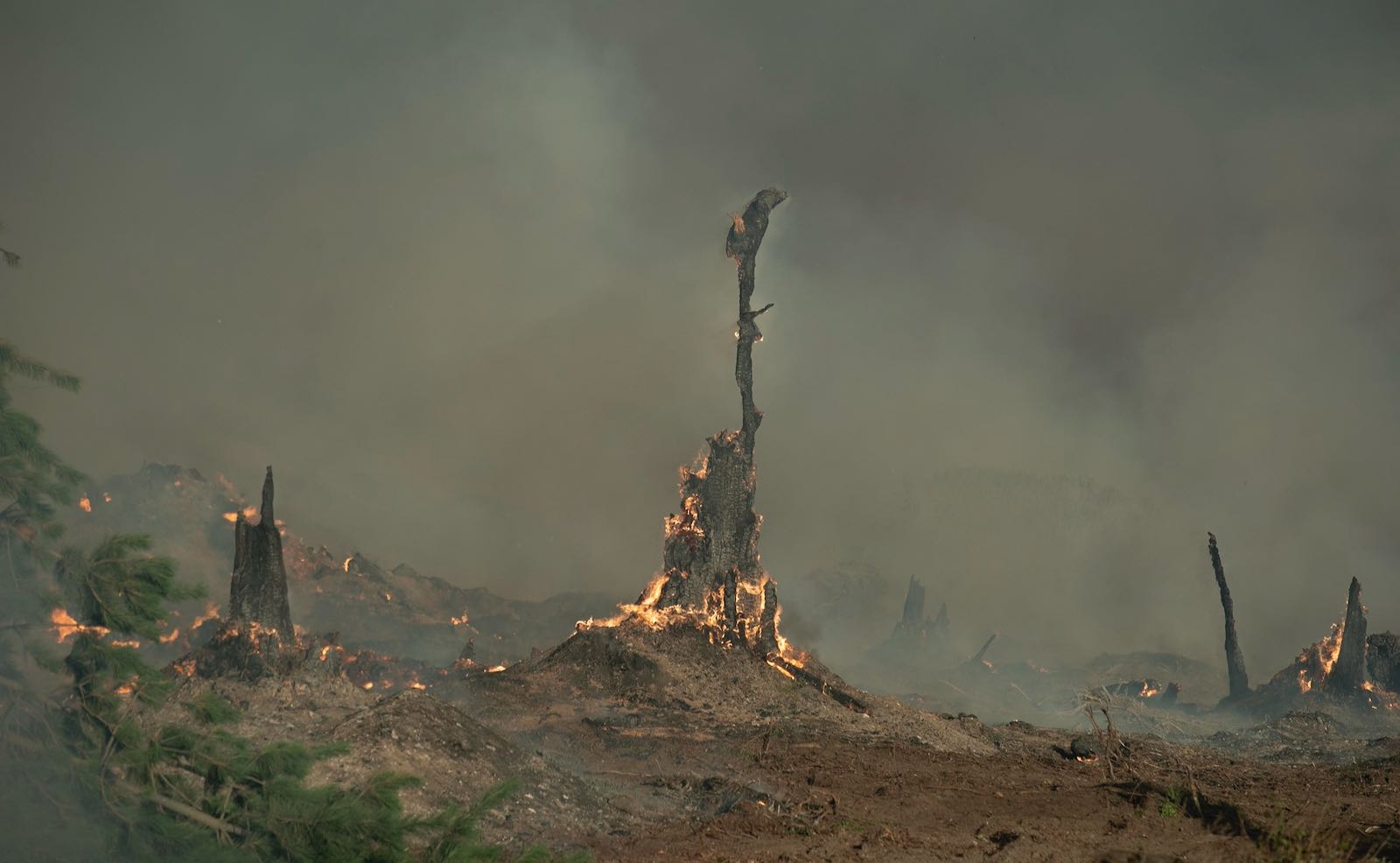Oakland, California—On Tuesday, September 8, my husband and I were hiking along Pelican Bluffs Trail near Gualala, a tiny coastal town in Northern California’s Mendocino County, to which we’d come to escape from the heat and the wildfire smoke already plaguing the Bay Area. It was a dramatic walk, with views of white cliffs, pristine beaches, and the endless expanse of the Pacific Ocean, whose intense blue was rivaled only by the skies above it. As a flight of pelicans vanished into the patch of ocean fog, I reminded myself of how lucky I was: seventeen years into my life in the great state of California, it still felt as if I’d barely scratched the surface. Then I glanced up and noticed a gray halo around the suddenly orange sun. It’s just sea fog, my husband told me; it doesn’t get smoky on the coast. The nearest fire, which had erupted over Labor Day at Willits, where we’d been planning a ride on the Skunk Train through the redwoods, was an hour and a half away—surely too far to cause this.
But our second hike that day, in nearby Sea Ranch, was an expedition into the unknown. The sun had disappeared, turning into nothing more than a diffused orange glow across a dense grayness that blanketed the marshlands around the Gualala River, the oceanside benches, the cypresses clinging to the cliff edges with their roots. The beach, a scintillating embodiment of the California Dream just a couple of hours earlier, now looked more like the landing pad for Charon, the mythological ferryman of Hades, with wisps of yellow smoke hovering above leaden waves and pebbles. For a while we lingered, enveloped in the fast-moving, sedating fog, then we scrambled back onto the path lined with squat bishop pines that somehow managed to retain their brilliant green in the world where color was quickly vanishing. It got colder.
The wooden domes of our Russian-style hotel were barely visible when we arrived, despite the clock’s showing two more hours before the sunset. Inside Osprey Cove, our cottage overlooking Route One, the panoramic windows displayed the same sepia color no matter where we looked, as though on a camera roll inadvertently exposed to light. We couldn’t even see the front deck, where the evenings before we’d tracked the constellations in the night sky. Our daughters, who had been distance-learning all day, reported that back home, in Oakland, the air was also “getting weird.” We went to bed early, half-hoping things would clear up by the next morning. This was the coast.
But September 9, 2020, was no better. The sun didn’t rise, sending out instead the same eerie glow. On the dry pine tree next to Osprey Cove, the namesake ospreys looked grounded, refusing to make their dramatic swoops over the water. After a brief walk, our white dog seemed to be wearing black sneakers. Ash fell from the sky, blackening our fingers as we packed our extended family’s two cars to go home. The temperatures had dropped from the low 80s to the upper 50s, and our still-wet swimsuits inside a plastic bag felt like a relic of a bygone era. Trawling my mind for apocalyptic precedents, I found I had no reference for what I was seeing other than a nuclear winter description drilled into me during initial military training classes back at my Soviet high school in southern Russia. My husband and mother were also born and brought up in Soviet-era Russia, but I kept the reminiscence to myself.
It was my turn to drive the convertible, but there was no fun in that now, the famed Route One barely visible in the yellow haze that grew even denser at lower elevations. Passing Fort Ross, the site of the nineteenth-century Russian colonists’ settlement, where a couple days earlier we’d been reconnecting with a more cheerful part of our heritage, I got a call from the hotel. Did you realize you have one more night with us, the hotel manager asked. I didn’t. What I did realize was that, for the second time in four days, I was fleeing.
My mother was riding in the car with me, so I asked her how this compared to things she’d lived through back in the USSR. She told me, after a pause, that the Cuban Missile Crisis had been scarier. Odd memories popped up as I focused on the taillights of my husband’s car, weaving along the steep curves and overpasses. The Air Seller, a sci-fi novel about Western imperialists slowly stealing the atmosphere in hopes of a handsome profit. The Last Day of Pompeii, a painting frequently reproduced on stamps in my youth. That I would be recalling those Soviet-era allusions in contemporary America seemed inconceivable, even taking into account the curtailed travel privileges, the dismal handling of the pandemic, and our waning democracy. On an AM talk radio show, where I’d somehow ended up searching for a signal, a male voice warned about a looming “socialist takeover.” How the end times will come, it occurred to me, is very much in the eye of the beholder.
Advertisement
That Wednesday of our return would be the last time we opened the doors and windows in our house, or went out in the backyard, the lawn still set up for last week’s outdoor movie, an entertainment our younger daughter had invented for us in the pandemic. On Thursday, the smoke, which until then had hovered above the “marine layer” air mass over the water, finally settled, ousting the Martian orange in the sky and blocking the light with the same ashen gray that had wound its way into everything—our parks, our tennis courts, our clothes, even our hair—a travesty in a state that makes a religion of natural beauty and youthful looks. As I flipped on a light switch to make our morning coffee, I thought of another home, a long time ago, where, in the winter, you had to walk to school in darkness. But there was nothing petrifying about that; it was ordinary.
The air quality, which we had learned to track on our phones in the previous three wildfire seasons, meteorologists by necessity, had plunged to “very unhealthy” overnight. It smelled strongly of smoke. In combination with an Air Quality Index value of 217 (anything above 150 is considered harmful even for healthy people) that meant the small space I’d carved out for myself from the chaos of our garage in order to write, was no longer usable. I tried to work on the living-room couch, listening to three Zoom calls echoing from three different rooms.
On one such call, a middle school drama class, the teacher was running a contest for the best description of the previous day’s orange sky. Voted winner: “Trump’s Tan.” Our children, who have studied climate change, understand what’s going on, as we do. But how, in the burgeoning culture of denial of science and facts, are we going to protect them? Especially now, when almost all their social interactions are virtual, mediated through increasingly toxic social media networks. Toxicity inside, toxicity outside.
Sealed off in our bungalow, with more bad news coming from Oregon and Washington, I kept scrolling through the towns in my weather app, but there’s no respite anywhere. Not at Stinson Beach or Point Reyes, mired in the smog from Woodward Fire. Not at Half Moon Bay, Monterey, Capitola, the coastal towns affected by the August Complex Fires. Not at San Luis Obispo, a halfway point en route to Los Angeles, or in LA itself, chocked by the smoke from the Bobcat Fire and the Dolan Fire near Big Sur. Not at Truckee or Reno, Nevada, near Lake Tahoe. The hills surrounding California wine country, around the towns of Healdsburg, Sonoma, and Calistoga, are ablaze. Smoke cloaks the Capitol in Sacramento. The Creek Fire, the Oak Fire, the LNU Lightning Complex Fire, the Almeda Fire… there’re so many, you lose track. And the smoke is everywhere.
So there’s nowhere to go. As an émigré, I know uprooting. What seems achievable or desirable in your twenties becomes a burden in your fifties. How many clean slates are available in one’s lifetime? And what are the odds of not ending up like a colleague of my husband’s—fleeing California only to find himself in the “hazardous” air in Portland, facing level two evacuation warnings? Or a classmate in Vancouver watching the vanishing skyline of one of the world’s cleanest, most eco-friendly cities, and choking on smoke from American wildfires, with AQI numbers at times hitting 400-plus? In the global era, individual safety may be an illusion. Misfortunes, whether in the shape of smoke, parasites, or authoritarians, travel fast.
“Just come to the state of California. Observe it with your own eyes,” Governor Newsom said. “This is a climate damn emergency. This is real.” When the president finally visited the state, for a mere two hours this past Monday, he told its suffocating residents to be patient: “It’ll start getting cooler. You just watch.” It felt like an inverted déjà vu of what Trump had said about the coronavirus in February, when he told Americans to wait till “when it gets a little warmer, it miraculously goes away.”
It is hard not to think of California’s wildfire plight as a metaphor for America’s decline, though hopelessness is not the Californian way. For the Russian in me, it feels familiar, even normal, to be abandoned by your government. But for the American I am, it doesn’t and never will.
Advertisement




